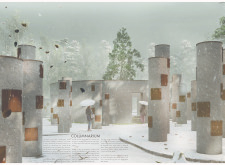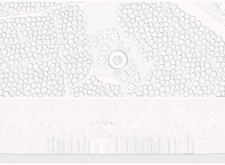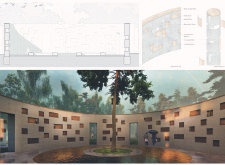5 key facts about this project
Materiality and Structural Elements
The Columnarium employs a diverse array of materials that contribute to both functional and aesthetic qualities. Concrete forms the primary structural component, providing durability and a modern aesthetic. Textured surfaces of concrete enhance visual interest while maintaining a connection with the surrounding landscape. Brass accents around the niches introduce warmth, enriching the tactile experience within the space. Glass elements are strategically incorporated to allow natural light to penetrate the interior, creating a fluid transition between indoor and outdoor environments. Natural stone is used in pathways, seamlessly integrating the design with its context, and wooden inserts in the niches further add dimension and comfort to the overall experience.
A notable aspect of the design is the circular configuration of the structure, which fosters openness and accessibility. This layout encourages visitors to navigate the space intuitively while offering both communal and secluded areas for contemplation. The tall cylindrical columns serve as symbolic markers of individuals, creating a visual narrative of diversity in memorialization experiences. Additionally, carefully placed pathways guide visitors through the columbarium and enhance accessibility for all users.
Innovative Design Approaches
Columnarium distinguishes itself through its innovative integration of natural elements within the architectural framework. The design seeks to create a sense of harmony between the building and its environment, utilizing landscaping as a key component. Native trees and shrubs are strategically positioned to provide a natural buffer, enhancing the ambiance and promoting a tranquil atmosphere. Water features integrated within the layout introduce auditory elements that contribute to the serenity of the space.
Lighting plays a significant role in the overall experience, with both natural and artificial sources employed to alter the ambiance throughout the day. This attention to light and shadow reinforces the contemplative nature of the design. Moreover, the varying heights and forms of the column structures signify individuality while collectively presenting a cohesive memorial landscape.
The Columnarium is unique not only in its architectural language but also in its prioritization of visitor experience and engagement. By reimagining traditional memorial structures, the project encourages visitors to participate actively in the experience of remembrance. This approach expands the understanding of memorialization in a contemporary context.
For more in-depth insights into the Columnarium project, including architectural plans, sections, and designs, readers are encouraged to explore the detailed project presentation. Understanding its architectural ideas will provide a comprehensive perspective on how this design effectively balances memory, architecture, and nature.


























